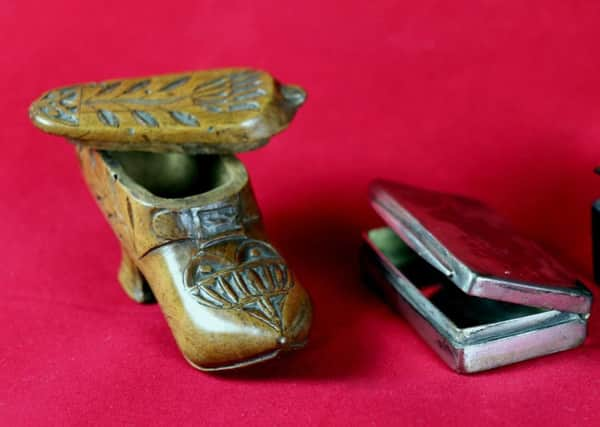Era when a pinch of snuff was fashionable


Although the use of nasal tobacco dates back hundreds of years by the indigenous peoples of Brazil who pounded the tobacco leaves with a pestle and mortar, its popularity in Europe peaked in the 18th Century. Queen Charlotte, wife of King George III was so fond of snuff she had a room at Windsor Castle devoted to her snuff stock and was given the nickname ‘Snuffy Charlotte’.
On her death in 1818 her snuff was sold by auction at Christies. This royal tradition was carried on by her son George IV who bought vast quantities of snuff. Both Queen Charlotte and George IV bought the majority of their snuff from the firm Fribourg and Treyer, whose shop at 34 Haymarket, London was established in 1720 and continued in business until 1981. Upon the death of George IV in 1830, Fribourg and Treyer bought back the King’s amassed stock and resold it at a premium.
Advertisement
Hide AdAdvertisement
Hide AdIn the late 18th and early 19th centuries the majority of snuffs were simply single origin tobaccos or blends, much like fine Scotch Whisky, with different designations depending on how coarsely ground it was; Fine, Demigros and Gros. The names of these snuffs were often associated with the origins of the tobacco and buyers could choose from a long list of individual and blended snuffs with exotic names such as Frankfort, Spanish Bran (very expensive at £3 a pound and moistened with rose scented vinegar), Masulipatam (from the East coast of India, and moistened with seawater), Morocco, Buenos Aires, Violet Strasbourg (Queen Charlotte’s favourite, scented with bitter almonds, ambergris and attar) and many more.
Blends were made to personal specifications and customers could either order their own or try the blends of the rich and famous such as King’s Morning Mixture, The Duke of Rutland’s Sort or Lord Edward Bentick’s Sort. Modern snuffs are often flavoured with the addition of scents such as menthol, camphor and various floral and fruit flavours (there’s even a Cheese and Bacon flavoured snuff available!)
When bought in bulk, snuff was often stored in highly glazed earthenware jars and then decanted into a snuffbox each day to ensure its freshness.
Snuffboxes came in many varieties and were often given as gifts by royals to visiting dignitaries. From humble boxes made of papier-mâché or even potato pulp, to highly decorative gold boxes inlaid with enamels and jewels, snuff boxes remain a popular collectors item to this day.
Advertisement
Hide AdAdvertisement
Hide AdIn fact in 2010 a Fabergé Imperial presentation snuffbox in gold and royal blue enamel set with diamonds and a watercolour on ivory miniature of Emperor Nicholas II sold at Christie’s for £937,250!
In Georgian Britain snuff was popular with the upper classes, but was also reasonably popular with working men, particularly in professions where naked flames were especially dangerous such as printing and coal mining. The great geologist William Smith, who was a founder member of the Scarborough Philosophical Society and suggested the round design of the Rotunda Museum was an avid snuff taker. Writing in his memoirs, William Crawford Williamson son of the first keeper at the museum, wrote the following about Smith:
“Smith was an inveterate snuff-taker. In those days the interchange of snuff-boxes was one of the most ordinary acts of social civility, and the large silver-mounted mull was to be found in many households. But Smith disdained the restraint of snuff-boxes. He carried his snuff loose in one of the pockets of his capacious waistcoat, whence he readily extracted frequent pinches of his favourite stimulant. The result was that his garments constantly exhibited vertical lines of snuff streaming down from the pocket in which the supply was stored.”
The snuff boxes in the Scarborough Collections are far from Fabergé mentioned earlier and are very much working class boxes being made of silver, pewter, papier-mâché and wood.
Advertisement
Hide AdAdvertisement
Hide AdAlthough snuff is nowhere near as popular as it once was, it still has a small but dedicated following and some advocate it as a way of giving up smoking. As a hobby we would suggest collecting snuff boxes rather than taking snuff, but its potential for harm reduction amongst smokers is not to be sniffed at.
The snuffboxes are part of the Scarborough Collections, the name given to all the museum objects and artwork acquired by the borough over the years, and now in the care of Scarborough Museums Trust. For further information, please contact Collections Manager (maternity cover) Simon Hedges on [email protected] or 01723 384505.